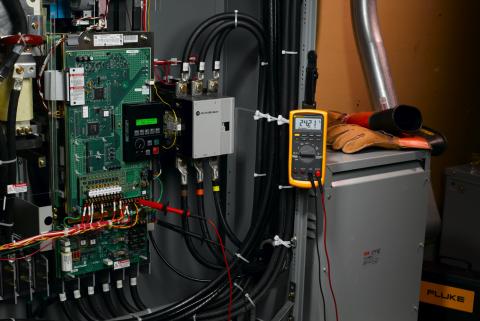保险丝就是保险丝。对吧?我们知道,当电流超过一定水平时,保险丝就会打开。这可以保护我们免受触电和过热电线引起的火灾。然而,有些保险丝保护我们免受更严重的危险。本文解释了使用没有熔断器保护的测试仪进行电压和电流测量的潜在危险,这些危险可能导致严重烧伤,甚至死亡。

为什么测试员需要保险丝?
市场上有各种各样的测试仪,从简单的电压检测器到高度复杂的数字万用表。进行电压测量的测试人员具有高输入阻抗,不太可能出现过流情况。因此,电压测量输入通常不设计熔断器保护,而是设计过电压保护。但如果同样的测试仪也被设计用来测量电流,则需要熔断器。电流测量输入通常采用一个简单的分流器,被测电流通过分流器流动。这个分流器的电阻约为0.01欧姆。再加上测试引线的电阻(约。0.04欧姆),你有一个小于0.1欧姆。当你把这个短路与另一个负载串联起来测量电路的电流时,这个电阻是足够的。但当你把这个电路放在一个电压源上时,情况就完全不同了,比如你客厅的插头插座。 This is an all too common mistake made by people measuring both voltage and current. After making a current measurement with the test leads in the current input jacks, the user tries to make a voltage measurement forgetting the leads are in the amps jacks. This effectively places a short across the voltage source. Years ago, when analog meters were the only instrument for making these measurements, this mistake pretty well destroyed the meter movement (the needle wrapped around the top peg), not to mention the internal circuitry. To protect against this common occurrence, meter manufacturers started putting a fuse in series with the meter's test lead jacks, for an inexpensive and effective solution for a very simple mistake. Today, most manufacturers still design their testers with fuse protection in the current measuring circuits. As technology has moved forward, the science of fuse design has progressed as well. Although understood by people who build testers, the full impact of fusing is little understood by most tester users. When you make that simple mistake of putting voltage across the current jacks and blow the fuse, you're at first thankful you didn't wipe out the meter. But you may then become annoyed with the fact that you have to hunt up a new fuse and replace it before making your next current measurement. Even more frustrating is when you share meters with other people in your shop and someone else blows a fuse and puts the meter away to have the problem discovered by an unsuspecting user.
测试员什么时候会变成手榴弹?
制造商在说明书上注明,经常在仪表上注明更换熔断器所需的刻度、中断和额定电压。如果你选择了一个没有这些评级的保险丝,或者更糟糕的是,在保险丝连接处放置一根电线,信不信由你,你刚刚创造了一个热手榴弹。你只需要合适的条件来触发它。在使用打印机、电脑、复印机或有独立电源(CAT I)的设备时,你可能不会发生爆炸。你甚至可以在分支电路(CAT II)上工作而不触发它。这两种环境能量相当低,通常有内置的保险丝保护、断路器和过流保护电路。然而,这不是一个好主意,也不是一个安全的工作方式。当您移动到配电柜(CAT III)或主馈线(CAT IV)时,保护电路发生显著变化。在配电面板上,你和电力公司之间有额定数百安培的断路器,而不是分支电路上的15、20或30安培断路器。当测量住宅断路器面板输入侧的电压时,保护现在又回到了电线杆或变电站。这些断路器在开启前可以携带数千安培,并且比分支断路器需要更多的时间来开启。 So when you accidentally leave the leads in the amps jacks and place the meter leads across one of these voltage sources without an appropriately-fused tester, you have put your life in grave danger.
等离子火球
在这种情况下,短路由错误的熔断器(或包裹在熔断器连接上的电线)和测试引线所提供的能量几乎是无限的。保险丝(或电线)中的金属元素迅速加热并开始蒸发,产生小爆炸。在错误的保险丝的情况下,保险丝外壳可能爆裂从爆炸的力量找到无限的氧气燃料等离子火球。测试导线也可能开始融化,很快就会着火,热金属会沾到你的手、胳膊、脸和衣服上。能量持续作用于测试者的时间、可用的氧气以及面罩和厚手套等安全设备的存在将决定你受伤的严重程度。这一切都发生在几毫秒之内,对错误做出反应的时间非常短。如果幸运的话,你可能会被抛离引线或测试器,从而破坏电路。但运气并不能指望太多,特别是当你可以通过使用合适的保险丝来完全避免这个问题的时候。
使用正确的保险丝
特别设计的“高能”保险丝旨在将这种电气短路产生的能量保持在保险丝外壳内,从而保护用户免受电击和烧伤。这些高能引信的设计目的是限制能量使用的时间长度和可用于燃烧的氧气量。保险丝不仅可以设计成在指定的恒流下开启,还可以设计成在瞬时大电流下开启。这个大电流被指定为“最小中断电流”。雷竞技app福禄克在他们的测试器中使用的保险丝具有最低中断额定值为10,000和17,000安培。如果你拿一个CAT III 1000v仪表,测试引线在安培插孔中,你将在引线之间有大约0.1欧姆的串联电阻(分路0.01欧姆,测试引线0.04欧姆,保险丝和电路板导体0.05欧姆)。现在,当你不小心将导线放在1000伏的电源上时,根据欧姆定律,你将产生10,000安培的电流(E/R=I, 1000 /0.1 = 10,000)。你需要一个能快速切断电流的保险丝。除了特殊设计的引信元件外,高能引信内还填充了沙子。沙子不仅有助于吸收爆炸元件产生的冲击能量,而且能量产生的高温(高达10,000华氏度)会融化沙子并将其变成玻璃。 The glass coats the element and smoothers the fireball by cutting off the available oxygen, keeping you and the tester safe from harm. As you can see, not all fuses of the same amperage and voltage rating are the same. For your own safety you need to be sure the fuses you use are the ones the engineer designed into the tester. Always refer to the tester's manual, or check with the tester manufacturer to ensure you have the correct fuse. You can always get replacement fuses for Fluke testers by ordering the part number listed in the tester's manual. Your safety is worth much more than the money it takes to purchase the proper fuse for which the tester was designed.